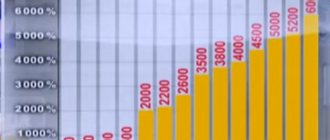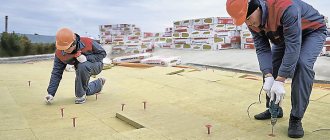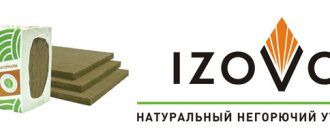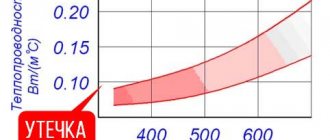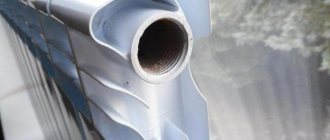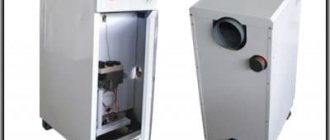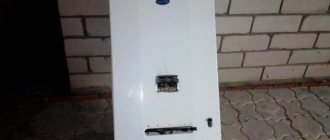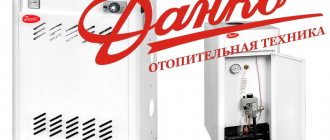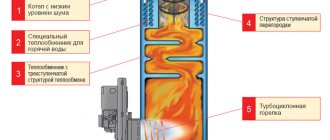Thermal insulation materials under the Rockwool and Isoroc trademarks are well known in the domestic building materials market. They are produced in Russia by joint ventures (with foreign capital). Rockwool is a more popular brand; its products are more expensive and are considered to be of higher quality. Isoroc products are cheaper, but their quality is comparable to their more famous competitor.
Need insulation? Buy in our store:
- To favorites
- Compare
- Quick view
Basalt insulation Isoroc Isolite 1000x500x100mm, pcs.
₽450
Thermal conductivity, W/m*K: 0.034 – 0.040 Water absorption by volume,%: 1.5 Compressibility,%: 15 Density, kg/m3: 50 Length, mm: 1000 Width, mm: 500 Thickness, mm: 100 Humidity by weight , %: 0.5 Content of organic substances by weight, %: 2.5 Flammability, group: NG Package weight, kg: 10 Quantity per package, pcs.: 4 Quantity per package, m2: 2 Quantity per package, m3: 0, 2
₽450 Add to cart
- To favorites
- Compare
- Quick view
Features of installation of mineral wool
The technology for installing thermal insulation depends on the type of insulated surface and the grade of mineral wool. General recommendations are as follows:
- the slabs are mounted in several layers, this eliminates cold bridges;
- the thermal insulation layer is protected on the warm side by a vapor barrier film, and on the cold side by a waterproofing or windproof film;
- material on inclined and vertical surfaces must be secured to avoid slipping and sagging; for this, glue, strips or dowels are used;
- It is necessary to take measures to ventilate the insulation; for this purpose, membrane films are used and air gaps are provided for steam removal.
Before installation, carefully study the instructions provided by the manufacturer. Use Isorok vapor-waterproofing membranes to protect the insulation from moisture.
Basalt insulation Isoroc Isolite 1000x500x50mm, pcs.
₽450
Thermal conductivity, W/m*K: 0.034 – 0.040 Water absorption by volume,%: 1.5 Compressibility,%: 15 Density, kg/m3: 50 Length, mm: 1000 Width, mm: 500 Thickness, mm: 50 Flammability, group : NG Quantity per package, pcs: 8 Package area, m2: 4 Package volume, m3: 0.2 Package weight, kg: 10
₽450 Add to cart
- To favorites
- Compare
- Quick view
Using Izorok insulation
The scope of application of materials of this brand is unusually wide.
“Izorok” is an insulation material that is most often used to insulate building envelopes from the cold. In addition, they are also used in the assembly of pipelines, as well as in the construction of industrial structures. The use of these heat insulators allows not only to increase the thermal properties of structural elements, but also to solve noise insulation issues, reduce fire hazards and reduce the load on the foundation. Lightweight options are especially popular among developers - Izorok insulation 75 and 50 (density). They are often used to insulate the walls of low-rise buildings.
In private households, Izorok can be used to insulate not only walls, floors, roofs and ceilings of a house. It is also used for insulation:
- Cellars and basements.
- Doors and garage doors.
- Balconies and loggias.
Thermal insulation of a house and various types of structures using this material is a simple and effective procedure.
Insulation Rockwool Light Butts Scandic 800x600x100mm, pcs.
₽650
Density: 37 kg/m3 Compressibility,%: 30 Thermal conductivity, W/m-k: 0.036 – 0.042 Length, mm: 800 Width, mm: 600 Thickness, mm: 100 Flammability, group: NG Quantity per package, pcs: 6 Area , m2: 5.88 Volume, m3: 0.288 Package weight, kg: 10.656
₽650 Add to cart
- To favorites
- Compare
- Quick view
Membranes
The use of building thermal insulation materials when insulating the walls of buildings helps to increase the thermal resistance of the structure and reduces the fire hazard. In addition, with their use it is possible to enhance sound insulation, improve the characteristics of humidity conditions, and also reduce the load on the base of the building. Izorok materials have long gained great popularity among consumers.
In the construction of modern buildings, Isorok insulation materials are often used, but for ease of operation they require good protection. For this purpose, membrane materials with a specialized structure have been developed, thanks to which the products provide good thermal insulation characteristics. Membrane films are highly durable, resistant to rupture, and have excellent performance characteristics. Working with them is convenient and quite easy - this helps to significantly reduce the time required for production and installation work.
Membrane materials are used as decorative coatings that protect the thermal insulation structure. Available in the form of sheets rolled into a roll. This form provides more convenience in installation of products.
ISOROC FOIL-HI, -LHI materials are produced in the form of three-layer membranes with high vapor-permeable properties. They are used in construction work to create wind protection, water protection in insulated pitched roofs, and when constructing a ventilated facade. The product is highly resistant to ultraviolet rays. The use of the membrane is recommended in conjunction with insulating materials of the Isorok brand - in this way it is possible to significantly improve their heat-protective characteristics and increase the service life of the structure.
The ISOROC FOIL-VB variety is an active vapor barrier membrane that can protect the insulating layer from water vapor that escapes from the living space to the outside. Its use has many advantages. The use of this material, if the technology is followed correctly, will help the thermal insulation remain stable, and the service life of building structures increases several times.
Both retail and wholesale supplies of building materials are possible.
Application: protective and decorative coatings
Insulation Rockwool Light Butts Scandic 800x600x50mm, pcs.
₽650
Density: 37 kg/m3 Compressibility,%: 30 Thermal conductivity, W/m-k: 0.036 – 0.042 Length, mm: 800 Width, mm: 600 Thickness, mm: 50 Flammability, group: NG Quantity per package, pcs: 12 Area pack, m2: 5.76 Pack volume, m3: 0.288 Package weight, kg: 9.2
₽650 Add to cart
These insulation materials are made from mineral fibers. The basis for their production is natural raw materials of magmatic origin - basalt fibers. They are intertwined with synthetic fibers and binders. And in slabs for insulating facades, they are additionally bonded with resins.
Purpose and brands of insulation
Types of insulation for interior work
These mineral slabs are intended for sound insulation and insulation of various building structures. Such structures include inclined, vertical and horizontal surfaces. It can also be used for insulation of frame wall structures, and even for the manufacture of partitions, as insulation in frame walls, attic and interfloor ceilings.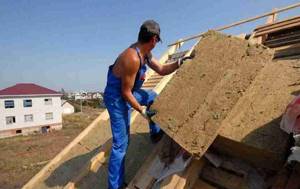
Isolite.- Izoruf. Mineral slabs are used as a thermal insulation layer to create structures in a horizontal position. It can be a flat roof; multi-layer insulation is acceptable. Another example is the thermal insulation of the floor in cases where the rough foundation is carried out using the dry method, i.e. there is no cement-sand screed. Recommended for use in single-layer coatings. Typically, in this case, two types of this insulation are used - the top layer is made of Isoruf B, and the bottom layer is made of Isoruf N. Such varieties can be used as a thermal insulation layer in sandwich panels that have a metal shell.
- Isoflor. These are special mats with high density, which are used in construction work as an intermediate layer in reinforced concrete structures, as well as for creating thermal insulation and sound insulation of interfloor ceilings. The same material is used to create the floor when performing wet screed or self-leveling floors. Isoflor can also be an element of sandwich panels with a metal shell.
Types of insulation for external work
- Isovent. Mineral wool slabs, which are used in construction as sound insulation and thermal insulation for various types of structures, such as well or layered masonry. This option will also be no less suitable when insulating a building using the technology of suspended ventilated facades.
- Isophas. Mineral slabs, which are recommended to be used to create insulation along the outer perimeter of the walls of a building, provided that the work is carried out using the wet method. The types of slabs Isofas 140 and Isofas are most often used for thermal insulation of facades where plastering is used. The same brand with numbers 90 and 110 is used in cases where the layer of plaster is thick. Plastering is carried out using steel reinforcing mesh.
Please note that the most popular among private construction are Isorok 50 with a density of 50 kg/m3 and Isorok 75 with a density of 75 kg/m3, respectively. On average, you will have to pay 400 rubles for packaging. The material is suitable for both external and internal work.
Technical types of insulation. Products are presented in the form of pierced mats and heat-insulating cylinders
- Isorok M2-100, M1-100. This is a material for sound insulation and thermal insulation, and its scope of application includes insulation of building structures of various types, as well as industrial equipment, which is used even at temperatures from -180 to +700 degrees. An additional option is the stitched mat M2-100, which is produced on a metal mesh. The last representative will be the M3-100 mat, which, among other things, has an additional coating of another material for thermal insulation - fiberglass.
- Ishell_ts and Ishell-CF . Such heat-insulating foil cylinders and half-cylinders are intended for insulation of process pipelines. Operating temperature range from -180 to +400 degrees. The price for such Izorok insulation, reviews of which are only positive, range from 450 to 600 rubles per package.
Advantages of thermal insulation made from basalt fiber
One of the main advantages of this material is its non-flammability , absolute resistance to fire. Rockwool and Isoroc thermal insulation will never cause a fire to start or spread.
Another advantage is hydrophobicity and vapor permeability. The material, despite its “typical cotton” structure, does not retain or accumulate moisture from the air . Its impact does not violate the structure of the material, its properties and performance characteristics. Of course, this does not mean that the thermal insulation material is waterproof. After all, it is cotton wool, so you can’t pour water on it or leave it in the rain: it will become saturated with water and will dry out for a very, very long time.
The advantages also include the high density and uniformity of thermal insulators. These properties eliminate the previous problem of such loose insulation materials - bald spots and uneven weave of fibers. They are practically never found in Isoroc and Rockwool materials.
The density also ensures a long service life of the thermal insulation system. Basalt wool will serve for 50 or even more years without losing its performance properties.
Real savings in energy spent on heating and air conditioning are also a significant plus. It turns thermal insulation into a one-time investment that will pay for itself many times in the future.
An additional positive property is providing a higher level of sound insulation in the room.
Application area
In the Isorok product line, all types of insulation differ from each other and include slabs for sound insulation and thermal insulation, have vapor barrier and waterproofing membranes, and there are also pierced mineral wool mats. Isorok insulation has a wide range of applications and can be used for the construction of various structures, residential and industrial buildings, and is also used for repair work and reconstruction. This list includes both temporary structures and those buildings that are planned to be used for long-term use.
Depending on the selected material density, it can be used for:
- Floor insulation.

Internal thermal insulation of walls.- Insulation of roofs and attic structures of various buildings.
- In multi-apartment buildings for soundproofing premises.
- Thermal insulation of all types of communications.
- Increasing the performance indicators of anti-seismic type of any structures.
Industrial type products are used for:
- Creation of thermal insulation of pipelines in basements and above ground.
- Insulation of pipes that are used to transport liquids with negative and positive temperatures.
Each type of work has its own brands of Izorok insulation, reviews of which are mostly positive, since people select exactly what is required for their needs (those brands of insulation that are best suited for their characteristics and properties). In order to accurately make a choice, you should know the purpose of a particular brand. This will make it easier for you to choose exactly the material that will guarantee the quality of the work.
Disadvantages of Rockwool and Isoroc thermal insulators
These brands of insulation also have certain disadvantages. One of the most significant of them is seams , which cannot be avoided during the installation process. So-called “cold bridges” are formed in them.
Other disadvantages include the toxicity of mineral basalt wool: phenol and formaldehyde are used in its production process, and the finished products also emit a tiny amount of volatile carcinogens into the atmosphere. When installing thermal insulation, dust - tiny particles of basalt fibers - can get into the air, and, consequently, into the human respiratory tract.
Therefore, when carrying out this work, it is better to use a mask or respirator.
Reviews
Tanya n, Lipetsk
To insulate the floor of the attic of a country house, Izorok slabs 1 x 0.6 m and 5 cm thick were taken. They were laid in two layers with a shift (to close the seams). For a floor area of 125 m2, 47 packages of 8 sheets were purchased.
During the preparation process, the slabs were cut using a paper knife. Cotton wool is very scratchy, so cutting and laying was carried out in respirators, rubber boots and gloves. A vapor barrier was installed on both sides of the insulation layer (material from the same manufacturer was used). This is done to minimize the likelihood of moisture getting into the mineral wool. Based on the results, I can note good sound insulation. Now we wait for winter to determine thermal efficiency.
iliya2002, Orel
I bought Izorok to insulate the walls and floor of the balcony. I chose it as the most inexpensive (360 rubles per package per 4 m2). I immediately noticed the light weight and the lady carried the purchase herself. The material is soft to the touch and easily deformed. I think to use wind and vapor protection for reliable thermal insulation.
Vladimir 68, Tambov
In my line of work, I often come across the insulation of premises. Many clients believe that the more expensive the better. But among budget products it is worth noting Isorok mineral wool. It is presented in a wide range, so everyone can easily choose the desired option. Mineral wool is easy to work with, it practically does not prick.
klim1983, Voronezh
I had long heard about Izorok insulation, and when it came time to insulate the facade, I chose it. It does not rot, is not flammable, and is not eaten by rodents (which is especially important for private buildings). The material provides good sound insulation and is suitable for facades, roofing systems, partitions and ceilings. And what’s even nicer is that all this is at a low cost.
I purchased standard sheets 100*50*5 cm. I laid them in two layers to cover the cold bridges. On top is siding. I would like to point out right away that in order to obtain decent insulation, it is important to follow the basic rules - to organize high-quality vapor barrier and wind protection.
I got a decent result. The house became much warmer in cold weather with lower heating costs, and cooler in hot weather.
Thermal insulation Izorok: new possibilities for budget insulation!
Russian production of foreign thermal insulation? Yes, yes, this happens too! Many people mistakenly believe that Isoroc is a domestic insulation material, but in fact, 100% of its capital even at the construction stage belonged to foreign companies from Germany and Austria. In 2021, the brand became part of the international trade group Saint Gobain, under whose leadership the popular mineral wool thermal insulation Isover and dry building mixtures Weber are produced.
The main advantage of Izorok thermal insulation boards is that they are at least 20% cheaper than their Rockwool counterparts.
This insulation is made from natural basalt fibers with the addition of a synthetic binder. Despite the budget cost, it also has many positive qualities:
- low thermal conductivity coefficient and effective thermal insulation;
- environmental cleanliness, safety for human health and the environment;
- fire resistance and the ability to protect valuable property in the event of fire;
- high vapor permeability and the ability to create “breathable” insulation;
- increased strength and preservation of positive qualities even under heavy load;
- good sound insulation and stabilization of noise levels in the room.
As for the right choice, if you have a limited budget, you should give preference to Isoroc thermal insulation, but if finances allow, buy Rockwool - proven by time and millions of people around the world. Still, the first material is still known only on a Russian scale, while the second is known in every corner of the globe.
Do you want to buy certified Rockwool thermal insulation, or have you decided to opt for a budget solution - Isoroc? Just call our manager and get detailed free advice and assistance in selecting materials specifically for your facility!

Thermal insulation tasks
For a good thermal insulation material, important properties are low thermal conductivity (the ability to transfer heat), low water absorption (the ability to absorb and retain moisture in the pores in direct contact with water), fire safety (the ability of the material to withstand high temperatures without ignition, damage to the structure, strength, etc.). d.), environmental safety (harmlessness to humans).
The lower the thermal conductivity coefficient, the less heat passes through the building envelope: in winter the room cools down slowly, and in summer it heats up slowly, therefore, you can save on heating or cooling it
Therefore, first of all, when choosing insulation, you need to pay attention to its thermal conductivity coefficient under operating conditions in a particular region (according to SNiP 23-02-2003 “Thermal protection of buildings” for the Nizhny Novgorod region, these operating conditions are designated by the letter “B”). The lower the water absorption. insulation, the better, because wet, wet insulation conducts heat well
This is due to the fact that the air pores of the insulation are filled with water, and water conducts heat much better than air. In addition, very wet insulation can simply freeze and “turn into a piece of ice”; in this case, there is no question of any thermal insulation. Water absorption is characterized by the amount of water that a dry material absorbs when kept in water, divided by the weight of the dry material. Therefore, when choosing insulation, pay attention to what this parameter is (it is indicated in the technical documentation for the material). When comparing materials from different manufacturers belonging to the same class of insulation, it is better to choose the one with less water absorption (this parameter is measured as a percentage).
The lower the water absorption of the insulation, the better, because wet, wet insulation conducts heat well. This is due to the fact that the air pores of the insulation are filled with water, and water conducts heat much better than air. In addition, very wet insulation can simply freeze and “turn into a piece of ice”; in this case, there is no question of any thermal insulation. Water absorption is characterized by the amount of water that a dry material absorbs when kept in water, divided by the mass of the dry material.
Therefore, when choosing insulation, pay attention to what this parameter is (it is indicated in the technical documentation for the material). When comparing materials from different manufacturers belonging to the same class of insulation, it is better to choose the one with less water absorption (this parameter is measured as a percentage).
The fire safety of the material is determined according to GOST 30244 “Building materials. Test methods for flammability" and GOST 30402 "Building materials. Test methods for flammability", SNiP 21-01-97 "Fire safety of buildings and structures". All materials are assigned a flammability group G4, G3, G2, G1 - flammable or NG - non-combustible materials. Of course, it is better to choose insulation belonging to the NG group for a frame or any other house.
In addition, the insulation should not be subject to significant shrinkage. Otherwise, during operation, cracks will form in place of the insulation, and the thickness of the material itself will decrease, which leads to the formation of cold bridges and an increase in heat loss.
Insulation for frame houses is made from a variety of materials and comes in various forms. These can be soft mats, which, for ease of transportation, are rolled into rolls or slabs, packed in several pieces in plastic film.
Structural features of the material
Izolight insulation belongs to materials of a high fire safety class. It does not support combustion and begins to melt only when exposed to temperatures above 400 degrees. A high degree of fire resistance allows the slabs to be used in the construction of fire-resistant structures.
The presence of an air gap between the fibers helps the material cope well with its main task - retaining heat. The same structural feature gives it excellent soundproofing properties.
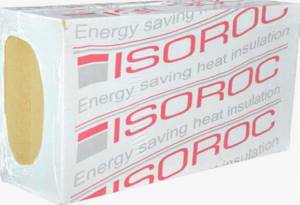
Despite the fact that all mineral insulation is considered quite vulnerable, Isoroc products prove the opposite. Polymer bonding of fibers makes the boards quite strong and resistant to various influences. Maximum density options can withstand even significant mechanical loads.
Impregnation with water-repellent compounds makes the product resistant to moisture and allows the material to retain its original structure for a long time. The likelihood of water penetrating inside the insulating layer is minimal, but if this happens, the insulation will dry quickly and will not change its appearance.
